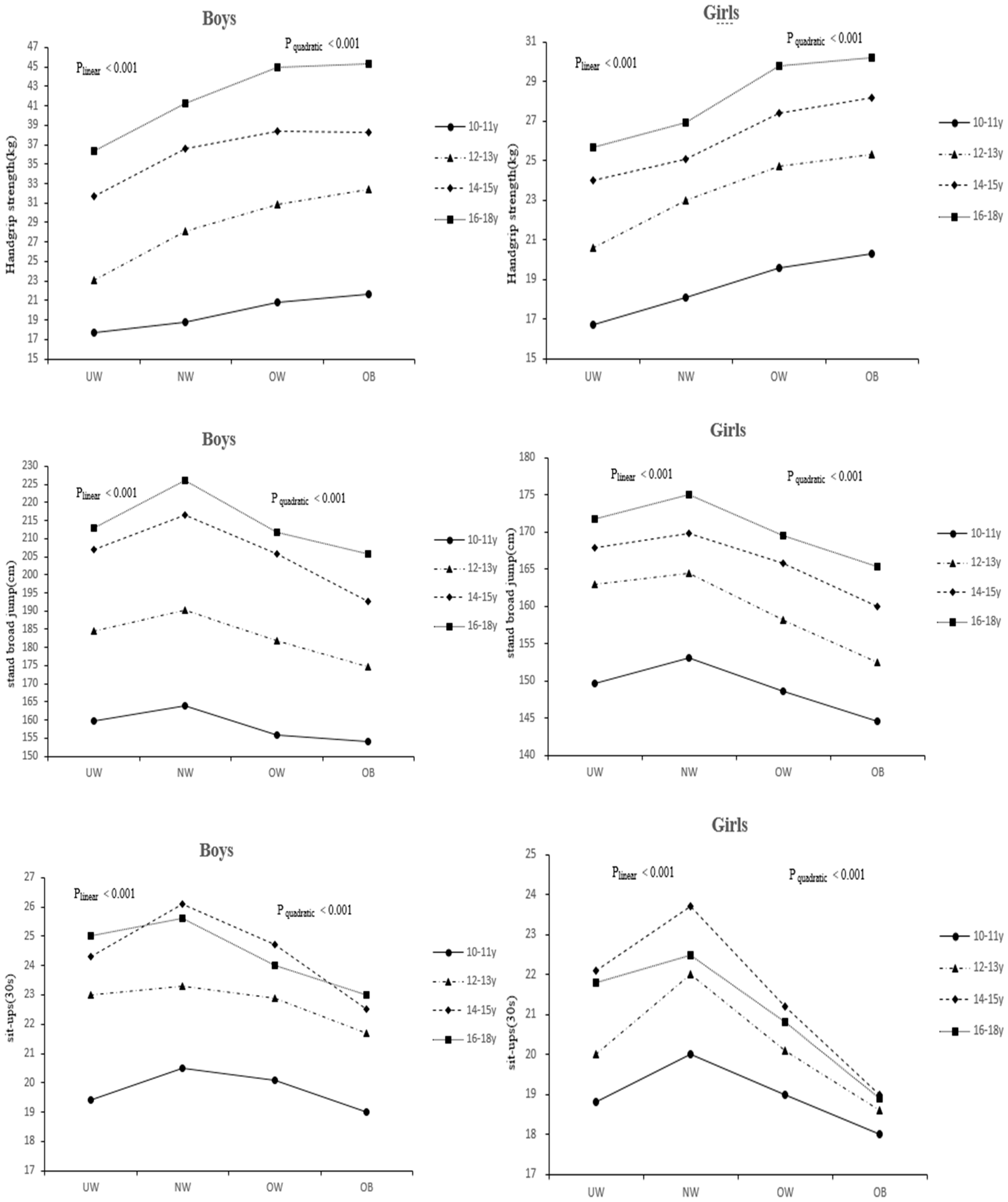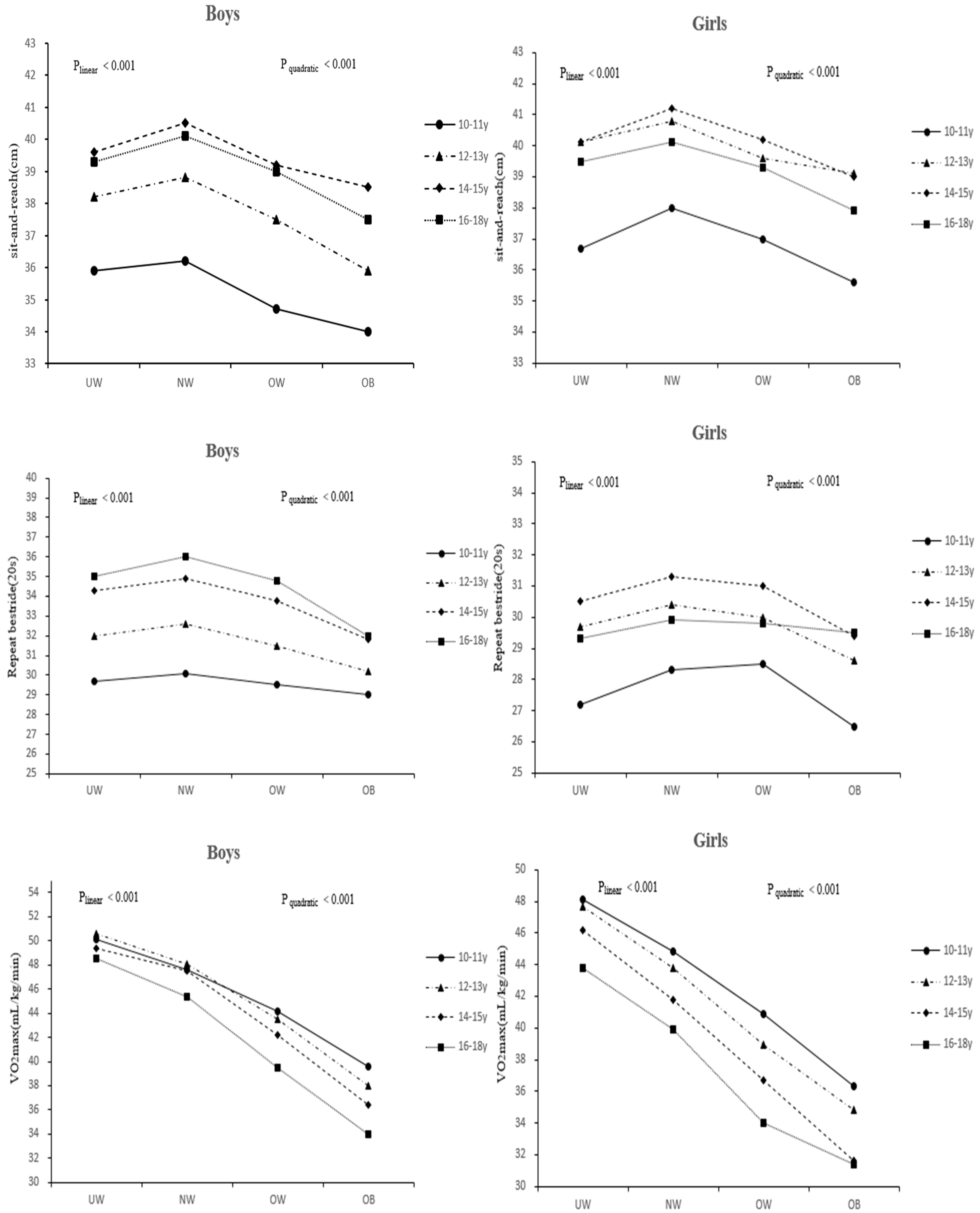Association between Weight Status and Physical Fitness in Chinese Mainland Children and Adolescents: A Cross-Sectional Study
Abstract
1. Introduction
2. Materials and Methods
2.1. Participants
2.2. Anthropometric Measurements
2.3. Physical Fitness
2.3.1. Upper Body Explosive Strength
2.3.2. Lower Body Explosive Strength
2.3.3. Abdominal Muscular Endurance
2.3.4. Flexibility
2.3.5. Agility
2.3.6. Cardiorespiratory Fitness
2.4. Statistical Analyses
3. Results
4. Discussion
5. Conclusions
Author Contributions
Funding
Acknowledgments
Conflicts of Interest
References
- WHO. Obesity and overweight. In Fact Sheet N°311; Available online: http://www.who.int/mediaCentre/factsheets/fs311/en/ (accessed on 13 October 2018).
- Evensen, E.; Wilsgaard, T.; Furberg, A.-S.; Skeie, G. Tracking of overweight and obesity from early childhood to adolescence in a population-based cohort – the Tromsø Study, Fit Futures. BMC Pediatr. 2016, 16. [Google Scholar] [CrossRef] [PubMed]
- Malina, R.M. Physical activity and fitness: Pathways from childhood to adulthood. Am. J. Hum. Biol. 2001, 13, 162–172. [Google Scholar] [CrossRef]
- Ruiz, J.R.; Castro-Pinero, J.; Artero, E.G.; Ortega, F.B.; Sjostrom, M.; Suni, J.; Castillo, M.J. Predictive validity of health-related fitness in youth: A systematic review. Br. J. Sports Med. 2009, 43, 909–923. [Google Scholar] [CrossRef] [PubMed]
- National Department of Sport. National student health survey results 2014. Chinese J. School Health 2015, 12, 77. [Google Scholar]
- Huang, Y.-C.; Malina, R.M. Body mass index and individual physical fitness tests in Taiwanese youth aged 9–18 years. Int. J. Pediatr. Obes. 2010, 5, 404–411. [Google Scholar] [CrossRef]
- Liao, Y.; Chang, S.-H.; Miyashita, M.; Stensel, D.; Chen, J.-F.; Wen, L.-T.; Nakamura, Y. Associations between health-related physical fitness and obesity in Taiwanese youth. J. Sports Sci. 2013, 31, 1797–1804. [Google Scholar] [CrossRef]
- Lopes, V.P.; Cossio-Bolaños, M.; Gómez-Campos, R.; de Arruda, M.; Hespanhol, J.E.; Rodrigues, L.P. Linear and nonlinear relationships between body mass index and physical fitness in Brazilian children and adolescents. Am. J. Hum. Biol. 2017, 29, e23035. [Google Scholar] [CrossRef]
- Gulías-González, R.; Martínez-Vizcaíno, V.; García-Prieto, J.C.; Díez-Fernández, A.; Olivas-Bravo, Á.; Sánchez-López, M. Excess of weight, but not underweight, is associated with poor physical fitness in children and adolescents from Castilla-La Mancha, Spain. Eur. J. Pediatr. 2013, 173, 727–735. [Google Scholar] [CrossRef]
- Artero, E.G.; España-Romero, V.; Ortega, F.B.; Jiménez-Pavón, D.; Ruiz, J.R.; Vicente-Rodríguez, G.; Bueno, M.; Marcos, A.; Gómez-Martínez, S.; Urzanqui, A.; et al. Health-related fitness in adolescents: Underweight, and not only overweight, as an influencing factor. The AVENA study. Scand. J. Med. Sci. Sports 2009, 20, 418–427. [Google Scholar] [CrossRef]
- García-Hermoso, A.; Correa-Bautista, J.E.; Olloquequi, J.; Ramírez-Vélez, R. Health-related physical fitness and weight status in 13- to 15-year-old Latino adolescents. A Pooled Analysis. J. Pediatr. (Rio J.) 2019, 95, 435–442. [Google Scholar] [CrossRef]
- Abarca-Gómez, L.; Abdeen, Z.A.; Hamid, Z.A.; Abu-Rmeileh, N.M.; Acosta-Cazares, B.; Acuin, C.; Adams, R.J.; Aekplakorn, W.; Afsana, K.; Aguilar-Salinas, C.A. Worldwide trends in body-mass index, underweight, overweight, and obesity from 1975 to 2016: A pooled analysis of 2416 population-based measurement studies in 128· 9 million children, adolescents, and adults. Lancet 2017, 390, 2627–2642. [Google Scholar]
- Dong, Y.-H.; Wang, Z.-H.; Yang, Z.-G. Epidemic status and secular trends of malnutrition among children and adolescents aged 7–18 years from 2005 to 2014 in China. J. PEKING University (Health Sci.) 2017, 49, 424–432. [Google Scholar]
- Mak, K.-K.; Ho, S.-Y.; Lo, W.-S.; Thomas, G.N.; McManus, A.M.; Day, J.R.; Lam, T.-H. Health-related physical fitness and weight status in Hong Kong adolescents. BMC Public Health 2010, 10. [Google Scholar] [CrossRef] [PubMed]
- Zenić, N.; Foretić, N.; Blažević, M. Nonlinear relationships between anthropometric and physical fitness variables in untrained pubescent boys. Coll. Antropol. 2013, 37, 153–159. [Google Scholar]
- Research Group of Chinese Students’ Physique and Health. Report on Physical Fitness of Chinese Students 2010; Higher Education Press: Beijing, China, 2012. [Google Scholar]
- WHO. Growth Reference—WHO 2007 BMI-for-Age. Available online: http://www.who.int/childgrowth/en/ (accessed on 12 August 2018).
- Matsuzaka, A.; Takahashi, Y.; Yamazoe, M.; Kumakura, N.; Ikeda, A.; Wilk, B.; Bar-Or, O. Validity of the Multistage 20-M Shuttle-Run Test for Japanese Children, Adolescents, and Adults. Pediatr. Exer. Sci. 2004, 16, 113–125. [Google Scholar] [CrossRef]
- Huang, Y.-C.; Malina, R.M. BMI and health-related physical fitness in Taiwanese youth 9–18 Years. Med. Sci. Sports Exercise 2007, 39, 701–708. [Google Scholar] [CrossRef]
- Silverman, I.W. Age as a moderator of the secular trend for grip strength in Canada and the United States. Ann. Hum. Biol. 2014, 42, 201–211. [Google Scholar] [CrossRef]
- Ervin, R.B.; Fryar, C.D.; Wang, C.Y.; Miller, I.M.; Ogden, C.L. Strength and body weight in US children and adolescents. Pediatrics 2014, 134, e782–e789. [Google Scholar] [CrossRef]
- Jetté, M.; Sidney, K.; Lewis, W. Fitness, Performance and anthropometric characteristics of 19,185 Canadian forces personnel classified according to body mass index. Mil. Med. 1990, 155, 120–126. [Google Scholar] [CrossRef]
- Kim, J.-W.; Seo, D.-i.; Swearingin, B.; So, W.-Y. Association between obesity and various parameters of physical fitness in Korean students. Obes. Res. Clin. Pract. 2013, 7, e67–e74. [Google Scholar] [CrossRef]
- Casonatto, J.; Fernandes, R.A.; Batista, M.B.; Cyrino, E.S.; Coelho-e-Silva, M.J.; de Arruda, M.; Vaz Ronque, E.R. Association between health-related physical fitness and body mass index status in children. J. Child. Health Care 2016, 20, 294–303. [Google Scholar] [CrossRef] [PubMed]
- Tokmakidis, S.P.; Kasambalis, A.; Christodoulos, A.D. Fitness levels of Greek primary schoolchildren in relationship to overweight and obesity. Eur. J. Pediatr. 2006, 165, 867–874. [Google Scholar] [CrossRef] [PubMed]
- De Andrade Goncalves, E.C.; Augusto Santos Silva, D.; Gimenes Nunes, H.E. Prevalence and factors associated with low aerobic performance levels in adolescents: A systematic review. Curr. Pediatr. Rev. 2015, 11, 56–70. [Google Scholar] [CrossRef]
- Said-Mohamed, R.; Bernard, J.Y.; Ndzana, A.-C.; Pasquet, P. Is Overweight in stunted preschool children in cameroon related to reductions in fat oxidation, resting energy expenditure and physical activity? PLoS ONE 2012, 7, e39007. [Google Scholar] [CrossRef] [PubMed]


| Gender/Years | Underweight N (%) | Normal Weight N (%) | Over Weight N (%) | Obesity N (%) | p-Value |
|---|---|---|---|---|---|
| 10–11 | |||||
| Boys | 84 (3.4) | 1335 (54.1) | 595 (24.1) | 453 (18.4) | 0 |
| Girls | 115 (4.5) | 1786 (69.7) | 497(19.4) | 166(6.5) | |
| 12–13 | |||||
| Boys | 86 (3.4) | 1536 (61.2) | 565 (22.5) | 323 (12.9) | 0 |
| Girls | 64 (2.6) | 1929 (77.3) | 394 (15.8) | 108 (4.3) | |
| 14–15 | |||||
| Boys | 71 (2.8) | 1792 (71.5) | 434 (17.3) | 209 (8.3) | 0 |
| Girls | 56 (2.2) | 2111 (84.6) | 283 (11.3) | 46 (1.8) | |
| 16–18 | |||||
| Boys | 134 (3.5) | 3048 (79.9) | 461 (12.1) | 174 (4.6) | 0 |
| Girls | 112 (2.9) | 3497 (91.4) | 199 (5.2) | 18 (0.5) |
| Gender/Years | N | Hand Strength | Standing Board Jump | Sit-Ups | Sit-and-Reach | Repeat Bestride | VO2max | p-Value |
|---|---|---|---|---|---|---|---|---|
| Boys | M (SD) | M (SD) | M (SD) | M (SD) | M (SD) | M (SD) | ||
| 10–11 | 2467 | 19.8 (5.8) | 161.1 (23.7) | 20.1 (5.9) | 35.3 (10.9) | 29.5 (8.2) | 45.4 (4.2) | |
| 12–13 | 2510 | 29.1 (10.5) | 186.2 (27.9) | 23.0 (6.3) | 37.7 (10.7) | 32.3 (9.2) | 45.9 (5.1) | |
| 14–15 | 2506 | 36.9 (8.9) | 212.3 (28.1) | 25.5 (7.0) | 39.3 (11.1) | 34.3 (9.1) | 45.7 (5.2) | |
| 16–18 | 3817 | 41.7 (8.5) | 223.1 (26.4) | 25.3 (6.7) | 39.4 (11.4) | 34.5 (9.5) | 44.3 (5.0) | |
| Girls | ||||||||
| 10–11 | 2564 | 18.5 (6.2) | 151.5 (21.6) | 19.3 (5.8) | 37.1 (11.0) | 28.2 (7.7) | 43.6 (3.6) | 0.000 |
| 12–13 | 2495 | 23.3 (5.4) | 162.2 (20.7) | 20.0 (5.7) | 40.0 (10.9) | 30.2 (9.9) | 42.8 (4.0) | 0.000 |
| 14–15 | 3496 | 25.4 (7.1) | 169.0 (20.3) | 21.6 (6.5) | 40.1 (10.7) | 30.4 (7.8) | 41.1 (3.7) | 0.000 |
| 16–18 | 3826 | 27.0 (8.2) | 168.9 (19.0) | 21.4 (6.0) | 40.2 (11.0) | 29.9 (8.2) | 39.7 (3.5) | 0.000 |
| Age/Weight Status | Boys | Girls | ||||
|---|---|---|---|---|---|---|
| OR | 95 CI | p-Value | OR | 95 CI | p-Value | |
| 10–11years | ||||||
| NW | 1.00 | 1.00 | ||||
| UW | 1.309 | 0.758–2.263 | 0.034 | 1.579 | 0.972–2.566 | 0.043 |
| OW | 0.747 | 0.603–0.926 | 0.008 | 0.887 | 0.710–1.108 | 0.290 |
| OB | 0.957 | 0.749–1.223 | 0.728 | 1.382 | 0.930–2.054 | 0.110 |
| 12–13years | ||||||
| NW | 1.00 | 1.00 | ||||
| UW | 2.049 | 1.123–3.739 | 0.019 | 1.445 | 0.764–2.732 | 0.257 |
| OW | 1.039 | 0.833–1.295 | 0.735 | 1.094 | 0.846–1.416 | 0.493 |
| OB | 1.644 | 1.212–2.229 | 0.001 | 1.912 | 1.113–3.285 | 0.019 |
| 14–15years | ||||||
| NW | 1.00 | 1.00 | ||||
| UW | 2.900 | 1.883–4.466 | 0.003 | 0.785 | 0.434–1.422 | 0.425 |
| OW | 1.516 | 1.175–1.957 | 0.001 | 1.084 | 0.804–1.461 | 0.597 |
| OB | 3.089 | 1.466–5.509 | 0.000 | 1.459 | 0.675–3.153 | 0.036 |
| 16–18years | ||||||
| NW | 1.00 | 1.00 | ||||
| UW | 1.580 | 1.019–2.451 | 0.041 | 0.354 | 0.139–0.900 | 0.838 |
| OW | 1.542 | 1.205–1.974 | 0.001 | 0.955 | 0.613–1.487 | 0.764 |
| OB | 3.512 | 2.109–5.846 | 0.000 | 1.055 | 0.745–1.934 | 0.029 |
© 2020 by the authors. Licensee MDPI, Basel, Switzerland. This article is an open access article distributed under the terms and conditions of the Creative Commons Attribution (CC BY) license (http://creativecommons.org/licenses/by/4.0/).
Share and Cite
Xu, Y.; Mei, M.; Wang, H.; Yan, Q.; He, G. Association between Weight Status and Physical Fitness in Chinese Mainland Children and Adolescents: A Cross-Sectional Study. Int. J. Environ. Res. Public Health 2020, 17, 2468. https://doi.org/10.3390/ijerph17072468
Xu Y, Mei M, Wang H, Yan Q, He G. Association between Weight Status and Physical Fitness in Chinese Mainland Children and Adolescents: A Cross-Sectional Study. International Journal of Environmental Research and Public Health. 2020; 17(7):2468. https://doi.org/10.3390/ijerph17072468
Chicago/Turabian StyleXu, Yatao, Maorong Mei, Hui Wang, Qingwei Yan, and Gang He. 2020. "Association between Weight Status and Physical Fitness in Chinese Mainland Children and Adolescents: A Cross-Sectional Study" International Journal of Environmental Research and Public Health 17, no. 7: 2468. https://doi.org/10.3390/ijerph17072468
APA StyleXu, Y., Mei, M., Wang, H., Yan, Q., & He, G. (2020). Association between Weight Status and Physical Fitness in Chinese Mainland Children and Adolescents: A Cross-Sectional Study. International Journal of Environmental Research and Public Health, 17(7), 2468. https://doi.org/10.3390/ijerph17072468





